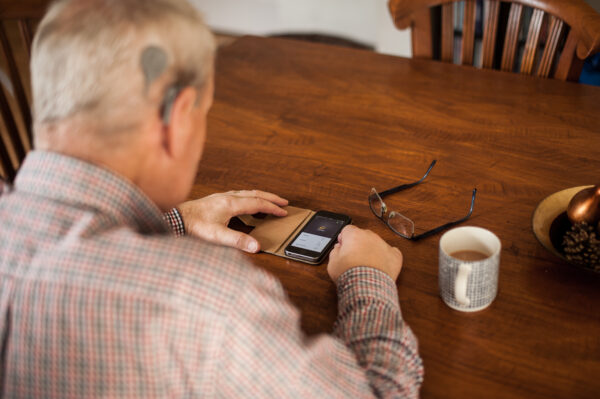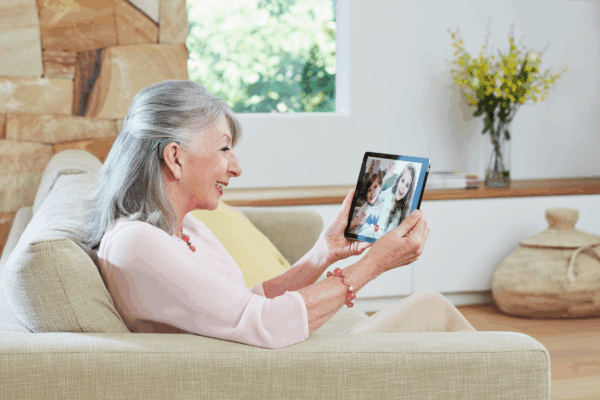When we talk to people with cochlear implants, one of the most popular features of the technology is being able to wirelessly stream sound directly from phone calls, music, podcasts and the TV directly through their sound processor.
Being able to stream audio from a smartphone or other device is often referred to as direct streaming. You can experience high quality sound streamed direct to your Nucleus® Nexa™ sound processor from compatible1 smartphones and devices.
How direct streaming helps you hear more clearly
Much research has been done on how direct streaming can deliver benefits to those who use hearing aids.2
Studies show that streaming is also proven to offer benefits in hearing with a sound processor.345
As well as helping you enjoy more types of entertainment, work and study, it can also support your efforts to improve your listening skills. But how does it really help? And should you make the most of it?
How direct streaming helps
Direct streaming is all about delivering high quality sound straight to your sound processor from your compatible device. Typically, this means pairing your sound processor to a device such as a smartphone or TV. This delivers the audio without echo, reverberation, or degradation from the surrounding environment, giving you a clearer listening experience.
For example, if you are talking on the phone in a crowded place like a train station or on a bus, it can be hard to hear clearly. By streaming directly from your smartphone, the sound is sent straight to your sound processor, loud and clear, to help you hear the conversation better.
“To have my phone calls, my music, video conferences, and more all streamed directly from my iPhone has been life changing,” says Stacy, who has a cochlear implant and helps as a Cochlear Volunteer, providing valuable insights to people with hearing loss or who also have a cochlear implant.
One study found that recipients who used streaming to talk on the phone showed improved word recognition in quiet and in noise, compared to talking on the phone using the phone speaker held to the ear.6
Tips to improve your listening with direct streaming
As you advance in your listening practice, direct streaming can help you extend your listening skills in more ways.
1. Listen to music
Direct streaming can be used to enjoy music. To start, create a playlist with a variety of music styles and listen to them regularly. Depending on your individual progress, start with simpler or familiar songs and tunes and gradually move to more complex music, trying to distinguish instruments and voices over time. (We’ll share practical tips to reconnect with music in future content.)
2. Listen to audio books
Try listening to books and follow along with the printed text as well. By reading along, you’ll be able to pick up any words that were unclear or misheard. You can start with short or familiar books or stories and gradually move to longer or more complicated plots as you feel more confident.
3. Practice on the phone
Talk to friends and family on phone calls or video calls using direct streaming to try and improve your ability to follow and engage in conversations. For video calls, start building your confidence by talking to a close friend or family member, then gradually increase the number of people you can communicate with in group video calls.
“The clarity is so much better than holding it to your ear or holding it to the processor. It’s like someone’s talking directly into your ears. It’s fantastic and so much easier,” says Bernie, who has a cochlear implant.
The future of direct streaming
Direct streaming is going to become increasingly beneficial and popular as technology evolves to include more devices and more opportunities for you to connect with those around you.
The good news is, your Cochlear™ Nucleus Nexa sound processor is ready for the next generation of Bluetooth® technology, which will offer direct streaming from smart TVs, laptops and a growing list of personal devices, when it’s available. You’ll also be able to tap into public broadcasts at airports, theatres and other public venues using Auracast™ broadcast audio.7
“For me, streaming music and audio directly from my smartphone has been an absolute game changer. It’s helped me hear better by giving more control of my sound processor settings and opened access to a variety of audio sources. I no longer dread talking on the phone—I can hear with complete clarity whoever is on the other end,” says Barry, who works at Cochlear and has a cochlear implant.
Check out the Wireless TV Streamer on the online Cochlear Store.
- For complete smartphone compatibility information, please visit www.cochlear.com/compatibility
- Wolfe J, et al. Improving hearing performance for cochlear implant recipients with use of a digital, wireless, remote-microphone, audio-streaming accessory. J Am Acad Audiol. 2015 Jun;26(6):532-9.
- Warren C, Nel E, and Boyd P. Controlled comparative clinical trial of hearing benefit outcomes for users of the Cochlear™ Nucleus® 7 Sound Processor with mobile connectivity. Cochlear Implants International (2019 Feb); 20(3).
- Jespersen, Charlotte T. “A review of wireless hearing aid advantages.” The Hearing Review, vol. 19, no. 2, Feb. 2012, pp. 48-54.
- Wolfe J, et al. Evaluation of a wireless audio streaming accessory to improve mobile telephone performance of cochlear implant users. International Journal of Audiology. 2016;55(2):75-82.
- Wolfe J, et al. Improving hearing performance for cochlear implant recipients with use of a digital, wireless, remote-microphone, audio-streaming accessory. J Am Acad Audiol. 2015 Jun;26(6):532-9.
- As Bluetooth LE Audio compatible devices become available, a sound processor firmware update will be required to use certain features.Auracast™ broadcast audio capability is subject to third party adoption of the Auracast protocol.The Bluetooth® and Auracast™ word mark and logos are registered trademarks owned by Bluetooth SIG, Inc. and any use of such marks by Cochlear is under license.

